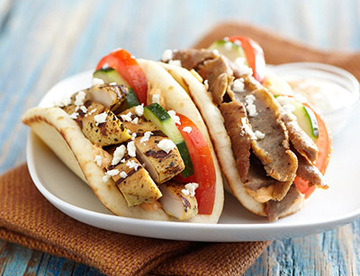More Food Topics
More Topic Categories
Related Destinations
Greek Cuisine
 The Greek cuisine is part of the Mediterranean cuisine, influenced by various Middle Eastern cuisines. Greek foods make substantial use of olive oil, vegetables, herbs, dairy, bread, fish and various types of meats.
The Greek cuisine is part of the Mediterranean cuisine, influenced by various Middle Eastern cuisines. Greek foods make substantial use of olive oil, vegetables, herbs, dairy, bread, fish and various types of meats.The most definitive characteristic of Greek cuisine is olive oil, of which Greece is a major producer, and is used in most dishes. Local vegetables are also used, including tomatoes, eggplants, potatoes, green peppers and onions. Lots of herbs and spices are also used, such as oregano, mint, dill, bay leaves, basil, thyme, while mastic, which is produced in the island of Chios, is also used in various Greek desserts. Various types of cheese are also produced in Greece, including feta, graviera, metsovone and mizithra.
It is common for Greeks to dine out and numerous places can be found throughout Greece. The most traditional type of restaurants is the taverna, serving traditional Greek food. Depending on its location, different dishes may be found; in mainland Greece away from the sea, most tavernas offer meat dishes, while if close to the sea, most dishes include fish, molluscs and shellfish. Fast food is also popular in Greece. Although international chains like McDonalds have practically closed down, the local burger chain Goody’s has been the prevalent fast food chain. Other types of fast food include gyros and souvlaki and numerous places are found everywhere in Greece. Pites (pies) are also a traditional and popular fast food in Greece, and many places offer tyropita (feta cheese pie), spanakopita (spinach pie) and more.
The Greek cuisine may be further subdivided geographically, each category having particular flavours. Examples are the Cretan cuisine, the Cypriot cuisine, the Macedonian cuisine, the Politiki cuisine (traditional food of the Greeks of Constantinople), and the Pontiaki cuisine (traditional food of the Pontic Greeks).
Appetizers are called mezes or orektiko, and may be offered either in special types of restaurants called mezedopolia, as a complement of drinks, usually ouzo or tsipouro, or as appetizers at a taverna. Examples of mezes are dakos (a Cretan appetizer consisting of dried bread with chopped tomatoes and feta or mizithra cheese), dolmadakia (stuffed grapevine leaves), horiatiki (country salad, better known outside Greece as Greek salad), kalamarakia (deep fried squid), melitzanosalata (aubergine dip), and tzatziki (dip made of yogurt, cucumber and garlic). Main courses include gemista (stuffed peppers with rice and/or minced meat), bamies (okra with tomato sauce), htapodi (grilled octopus usually complementing ouzo), keftedakia (fried meatballs), soutzoukakia (elongated meatballs with spices such as cumin and cinnamon, boiled in tomato sauce) and spetzofai (a stew of country sausage, peppers, onions and wine). Finally, desserts include baklava (filo layers filled with nuts and drenched in honey), galaktoboureko (custard – filled filo pastry drenched in lemon – honey syrup), halva (a nougat of sesame with almonds), rizogalo (rice pudding) and tsoureki (a traditional sweet bread scented with mahlepi, for Christmas and Easter).
See Also:
 Athens Photos
Athens Photos
 Santorini Photos
Santorini Photos
 Crete Photos
Crete Photos
 Meteora Photos
Meteora Photos
 Corfu Photos
Corfu Photos






